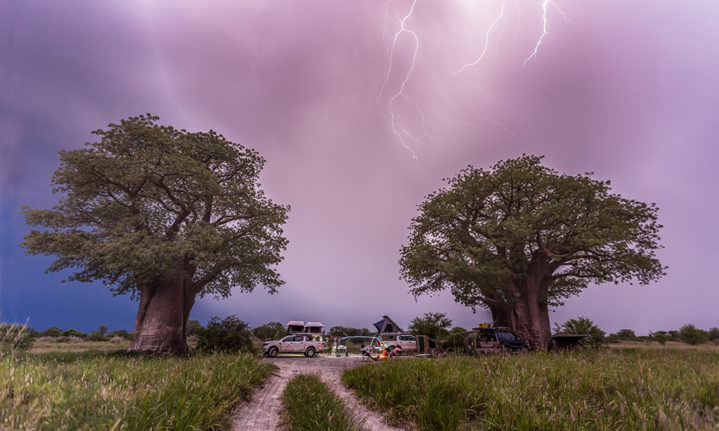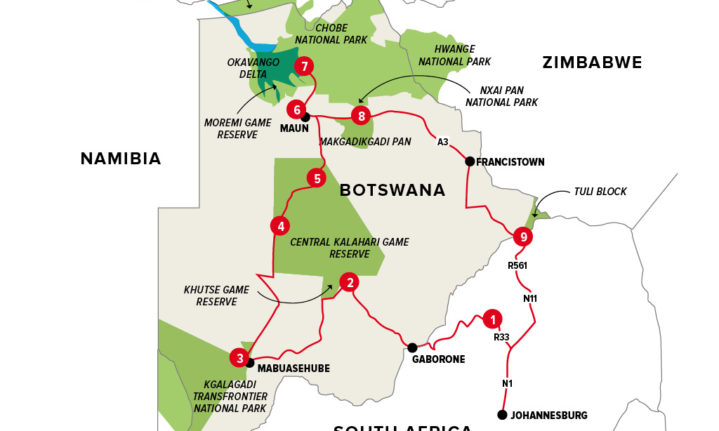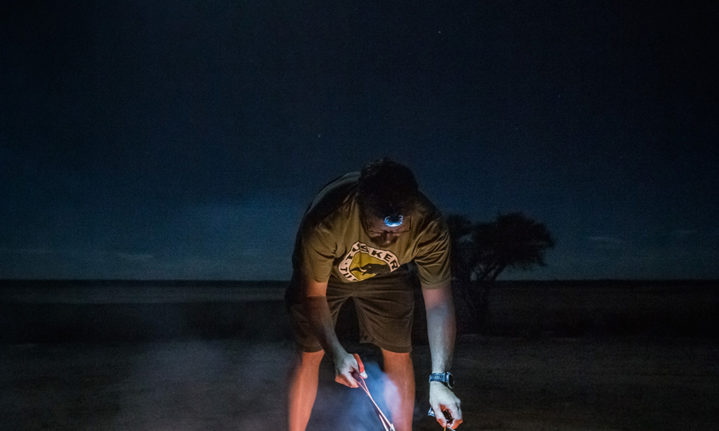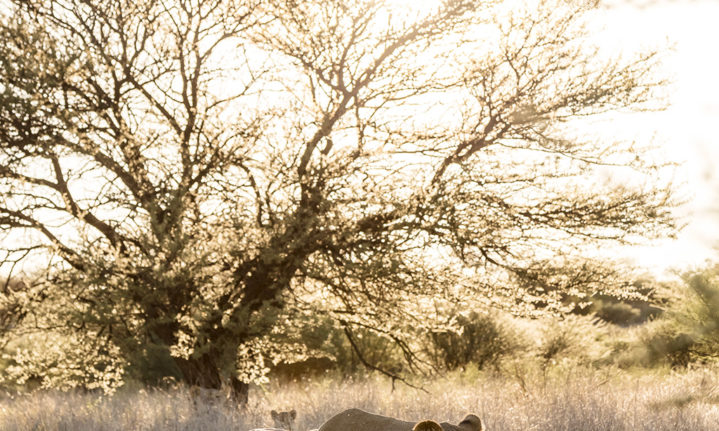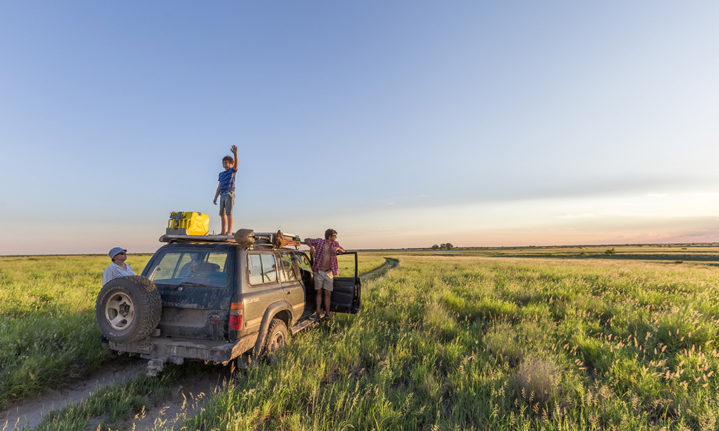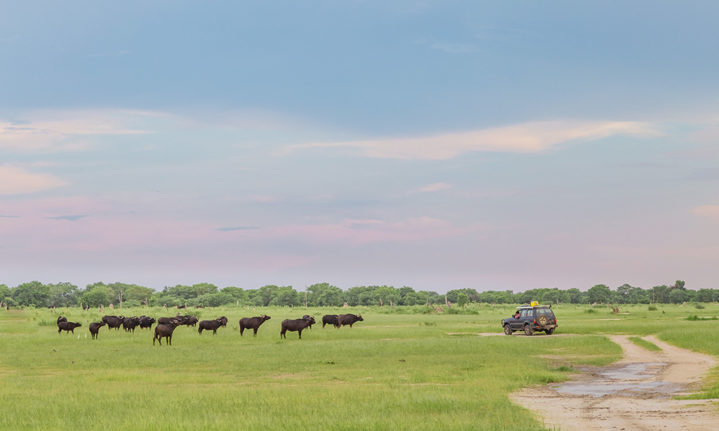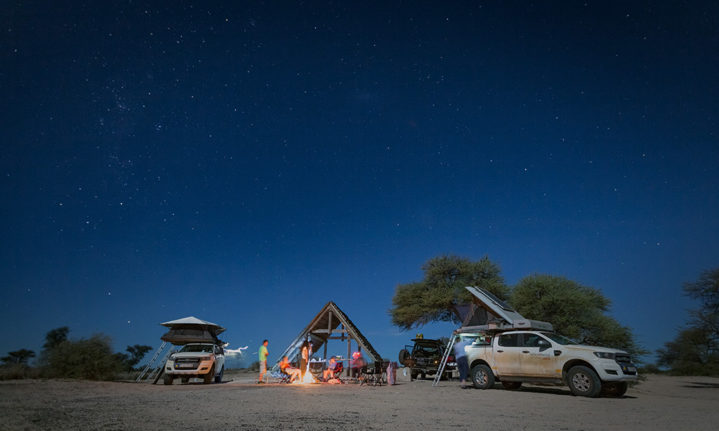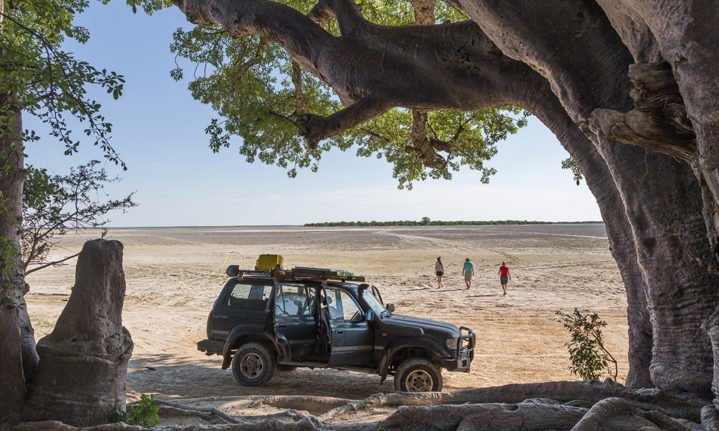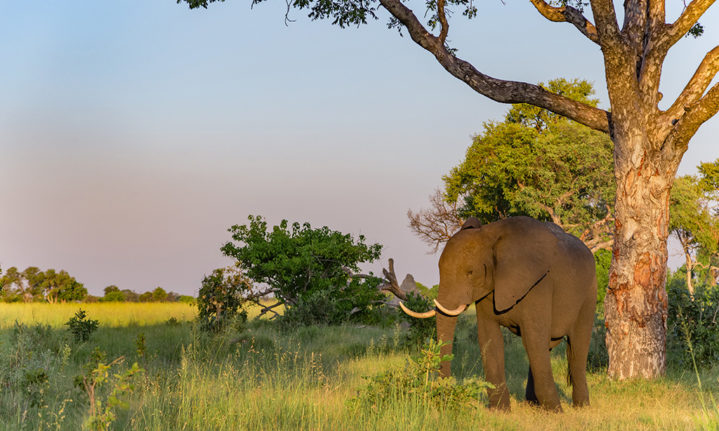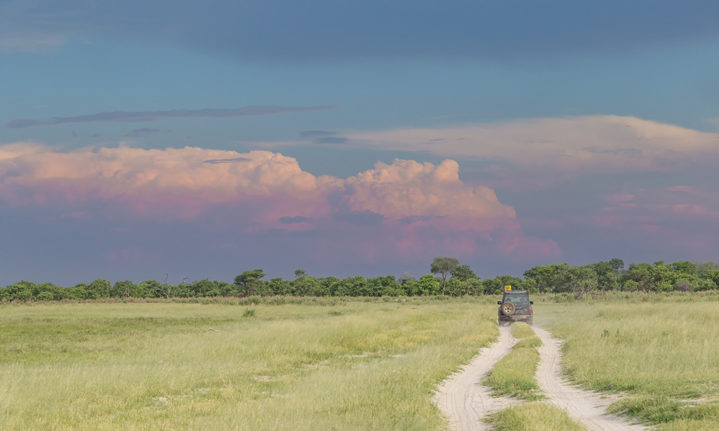When the summer rains soak Botswana, they transform the land completely. The Kalahari’s heart turns a brief, vivid green and for a few short months this is a land of plenty – and brutish thunderstorms.
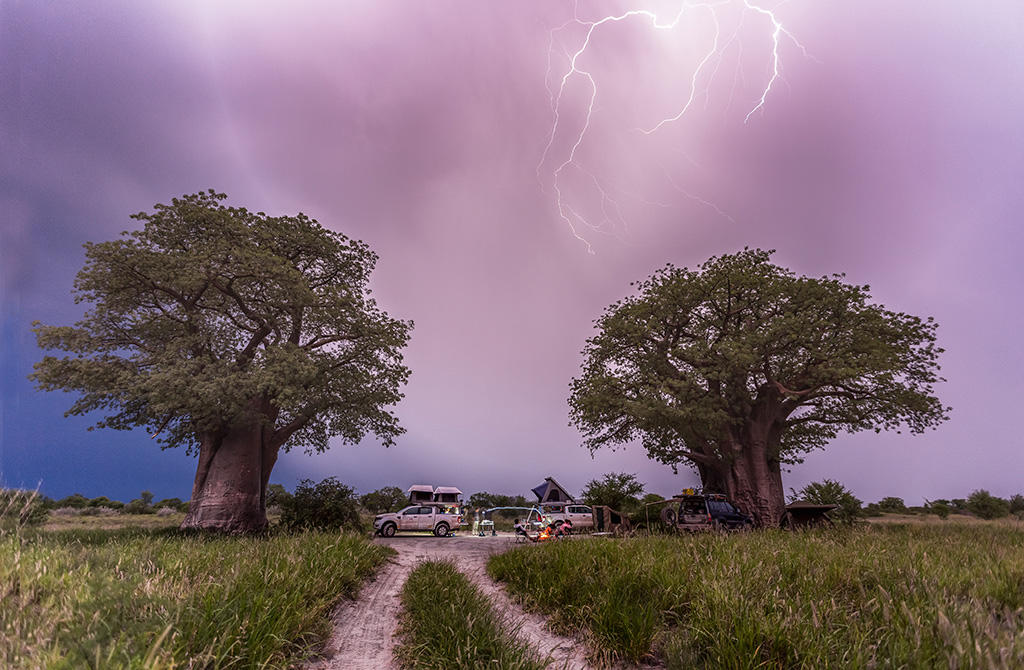
Baines’ Baobabs Camp 2, at Nxai Pan, at its magical best during a thunderstorm. Image credit: Chris Davies
Lightening flashed through peach and lavender clouds as we arrived at Khutse Game Reserve on the tail end of a storm. Flights of yellow-green butterflies billowed over the puddles which slopped thick, red mud up the sides of our 4x4s.
This was our first night on a two-and-a-half-week trip in Botswana, with a nine-strong group of family and friends. The happy mix included visitors from Cyprus and Ireland, and I’d briefed everyone to expect some mud and rain. No one, me included, had been to Botswana in the rainy season so mid-February was a gamble, but I was looking for something new.
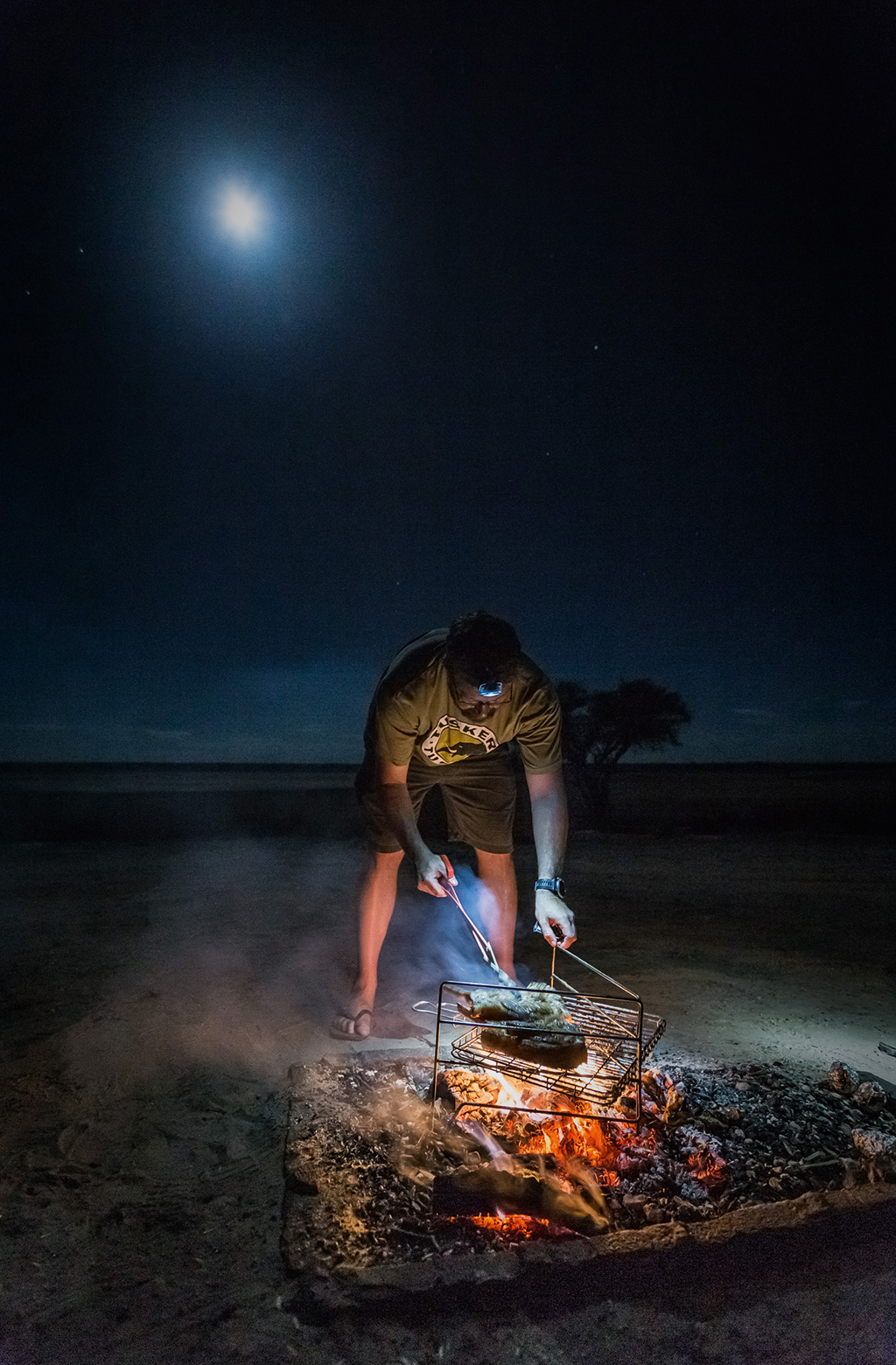
No doubting this was the smell that attracted our Mabuasehube brown hyena. Image credit: Chris Davies
Someone once told me an old Botswanan proverb: ‘Only a fool checks the depth of the water with both feet.’ And many will say that Botswana is best in the dry winter, when animals are easier to spot in the thinner bush, and gather in denser groups around the permanent water. But Botswana in the grip of winter can also seem bleached and withered. I was excited to see a greener Kalahari, so off our party went, jumping in with both feet.
Our two days in Khutse were lush and beautiful, but besides a few gemsbok and eland there was little wildlife. The thick vegetation hid all from view. No mud and no rain, but no animals either.
Pondering the conventional wisdom, we left Khutse and headed south, entering Mabuasehube (the eastern sector of the Kgalagadi Transfrontier Park) through a carpet of dubbeltjie flowers. Their bright yellow blossoms stretched out from the track, which ran dead straight and bone dry; no sign of recent rain. After a braai that night we settled in around the fire and Shona Muir, our friend from Cyprus, drifted off to brush her teeth. With a splutter, toothbrush waving, she was suddenly back-pedalling around the car. The moon was full, like a light bulb in the sky, and a large brown head peered out from the bushes.
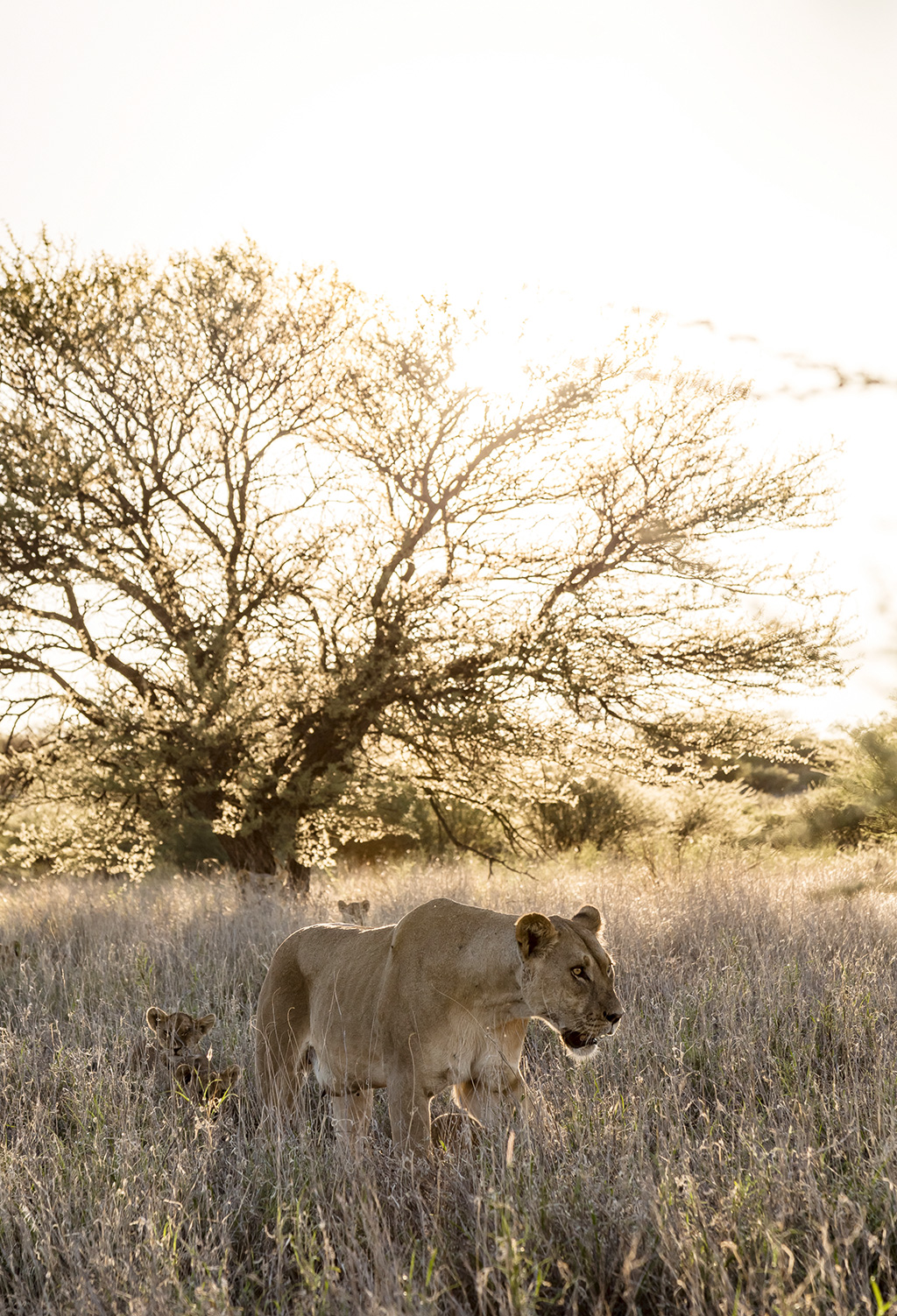
This lioness and cubs strolled between our vehicles in the Kgalagadi; hard to believe this lush grassland is Nxai Pan. Image credit: Chris Davies
Bit by bit a dark, shaggy animal emerged, then suddenly it was obvious – a beautiful brown hyena. There’s nothing wilder than a goat on either Cyprus or Ireland so it took a moment of whispered assurance that we were unlikely to become a meal. Grabbing another drink, we took up silent vigil around the fire, staring across the moonlit pan as our visitor patrolled the perimeter. On the next day’s game drive, we came across two lionesses and five cubs, perhaps 500 metres west of our camp. It was wonderful as they padded between the vehicles, and I felt much better for our visitors as we drove north to the Central Kalahari.
The last time I’d seen the Central Kalahari Game Reserve (CKGR) it’d been a dry and dusty July. Game had been scarce, but now the place was transformed – the dust bowl of Piper Pan now a vast pasture. Hundreds of springbok, gemsbok and wildebeest grazed across the plain. There were ostriches, zebra and some 30 giraffe, and a cheetah in the shade of a tree. It trotted away to a quieter spot and we stopped in an empty campsite for lunch. Despite the current blue skies, there had clearly been rain. This was the Kalahari I’d wanted to see. We continued north to Sunday Pan where we camped for four days that stayed stubbornly clear. I was feeling vaguely disappointed at the lack of rain, but only for brief moments, between the otherwise carefree cycle of late brunches, naps, braais and icy beers. We had lions around the camp at night and the next day followed their spoor to Leopard Pan. We never found them, but did see more cheetah in Deception Valley and left the CKGR relaxed and happy, for a restock in Maun, then three days in Moremi.
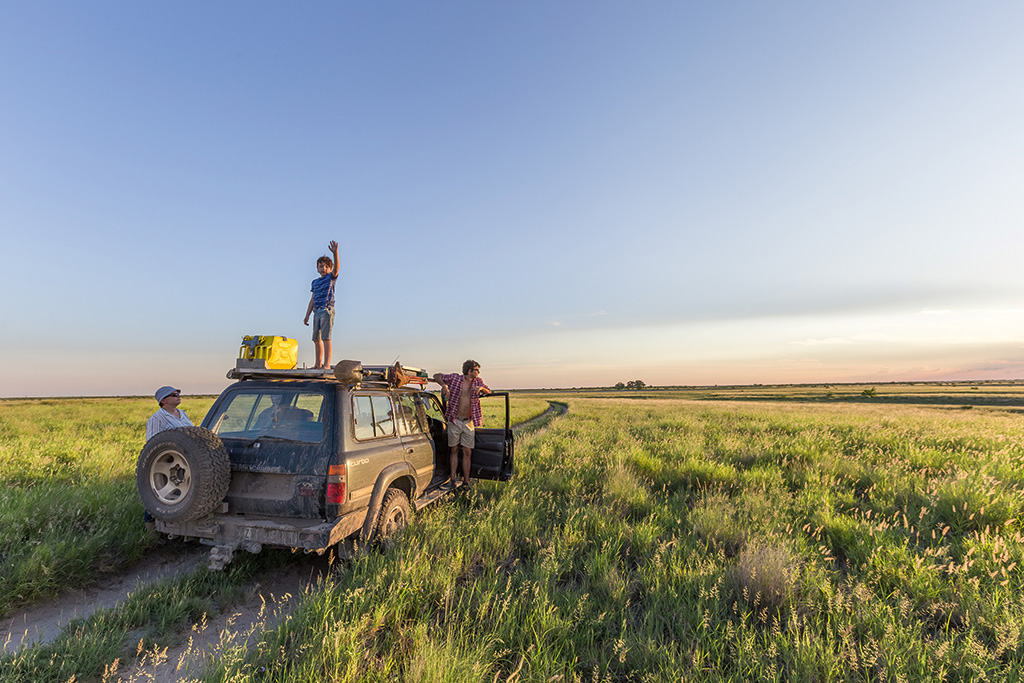
Hard to believe this lush grassland is Nxai Pan. Image credit: Chris Davies
The moment we turned onto Moremi’s South Gate road it was clear that things were about to change. All around us the grass stood tall and green and dark thunderheads loomed as we splashed our way through deep pools. Elephants wallowed in mud holes by the road and there were giraffe, zebra and wildebeest on all sides. Hippos trotted between the deeper ponds, while jacanas, herons, thick-knees and geese flocked along the banks. We arrived at Third Bridge Campsite amid a swarm of southern carmine bee-eaters, their bright red flashes dipping and darting around our wheels. Shallow lakes covered the open grassland before the camp, where juvenile zebras kicked and jumped in the light rain. On the Mboma Loop were two male lions and three young leopards, and the veld between Second and Third Bridge teemed with grazing buffaloes. In our campsite, a huge, beady-eyed hippo munched grass. We eased him out safely, but as the wind picked up several notches, a hitherto unimagined danger suddenly made itself known. A rustle from above gave little warning before an almighty clang as the first heavy missile speared its way down. I can now say with authority, and one severely dented Land Cruiser later: never camp under a sausage tree in a storm!
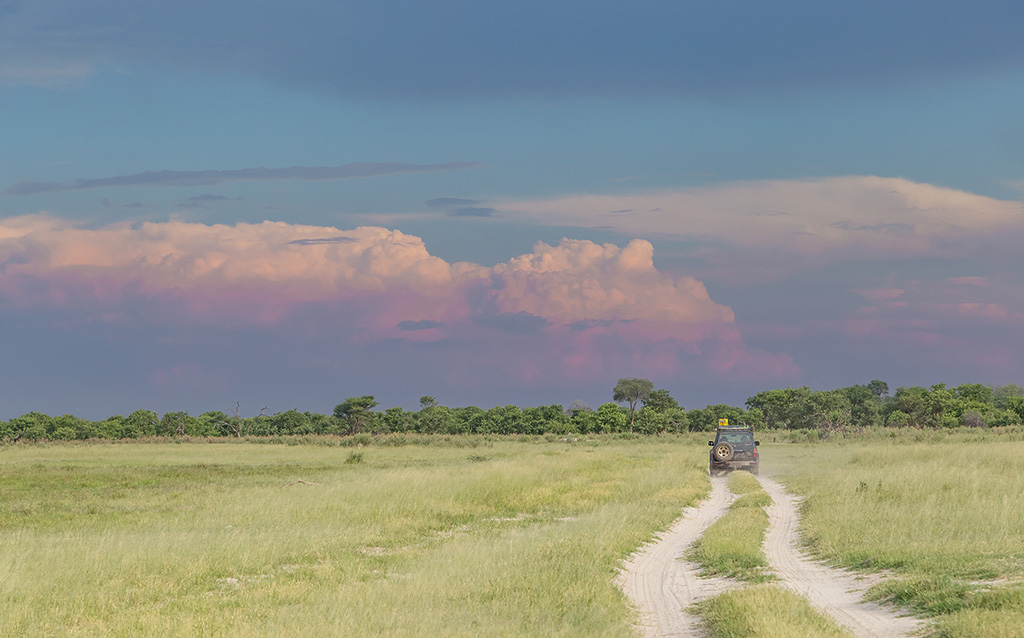
There’s every shade of green in Moremi’s diverse habitats of woodland, acacia forests and floodplains. Image credit: Chris Davies
We left Moremi three days later through a succession of muddy pools. And whatever misgivings I’d had about too dry a trip were completely banished in Nxai Pan National Park. The deluge thundered down, with the hot smell of rain, and even with wipers on full we could not see the road. Lightening flashed all around, and slammed into the ground, then as quick as it had started, the rain stopped and we drove on. Away in the distance the flashes continued, getting ever brighter in the gathering dusk light. A huge slab of blue-black cloud split the sky, and beneath it, on the horizon, hovered the orange ball of the setting sun.
Like most Kalahari storms, ours hit hard, and faded quickly, blinking its way off to the south. We were heading that way too, a few days later, to wrap up our green-season adventure that had begun and ended in rain. Sitting that night under a clear, starry sky, I realised this new side to Botswana had completely won me over. In the beautiful, lush bush we’d seen 23 big cats, plus thousands of plains game and fantastic summer birds. Maybe we got lucky – only the next trip will tell – but from the evidence of this one expedition, Botswana is beautiful when it rains!
Plan your trip

Getting There
The round-trip from Joburg was roughly 4 ,000km. You need a sturdy 4×4 for Botswana in the rainy season, fully-equipped for off-the-grid camping.
When to Go
Botswana’s green season runs from December to April. The first major downpours arrive in mid-November, with February the wettest. March and early April is the best time, when the bush is still lush, but storms abate.
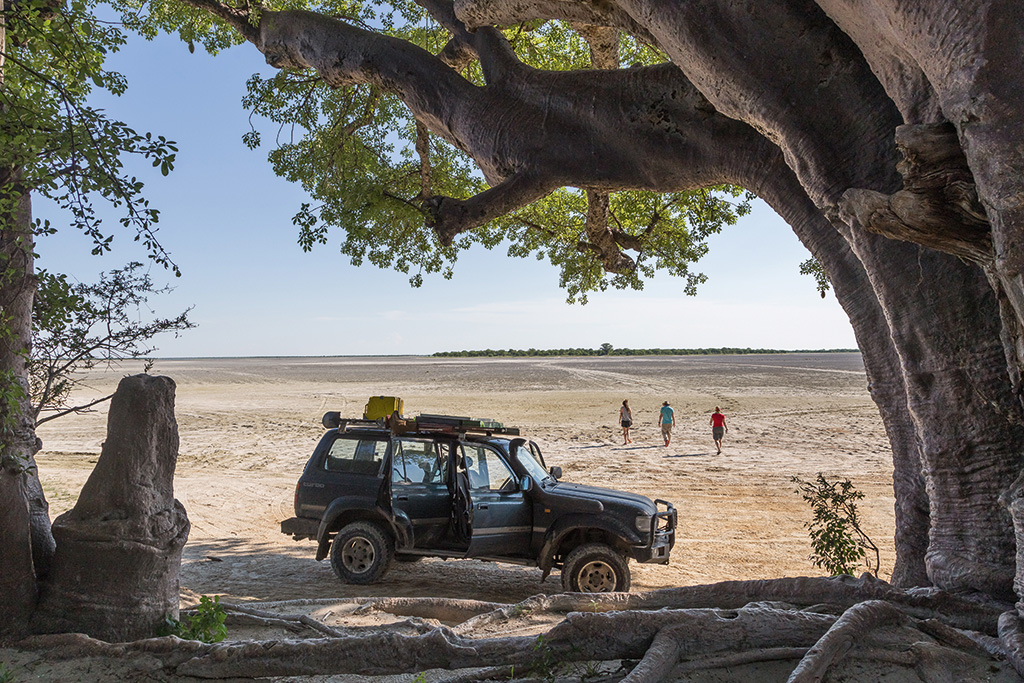
Looking out from the shade of Baines’ mighty baobabs, across the still-dry Kudiakam Pan in Nxai Pan National Park.
Need To Know
Heavy rain churns up dirt roads, especially tracks through or around salt pans. With little traffic, and deep pools across the roads, it’s highly recommended to travel with more than one vehicle. Things dry off quickly and consecutive rain days are rare, but an extra tarp or two is very useful as a shelter or to cover muddy ground. The Kalahari’s campsites are fenceless and wild. There’s no drinking water or facilities so take everything you need with you.
What It Costs
We hired two fully-kitted Ford Rangers from Avis Safari Rental (avissafarirental.com), from R1 ,520 a vehicle per day. Camping, food and sundries was around R10 000 pp plus R8 000 a vehicle for fuel. Total cost was R18 ,460 per person.
Stay Here
1. Matamba Bush Camp, with free-roaming game and beautiful private campsites is an ideal stopover between Joburg and Botswana. R300 per person; minimum two nights over weekends. 083-653-1287, matambabushcamp.com
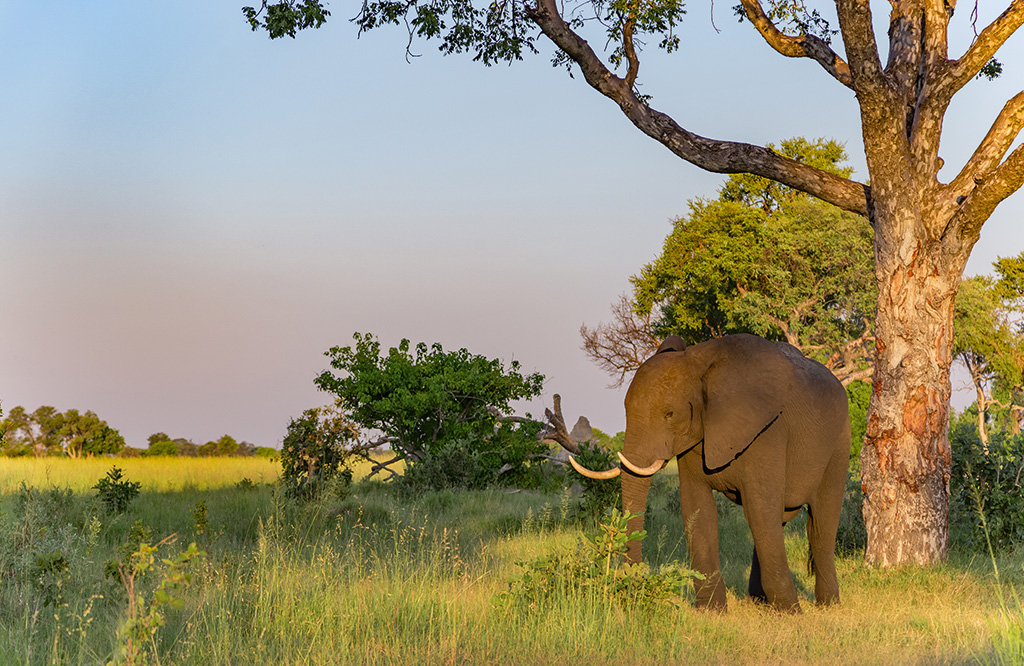
No one goes hungry in Botswana’s season of plenty and everywhere the animals looked well-fed, healthy and strong.
2. Khutse Game Reserve has five camping areas. Khutse Pans is the largest with 10 stands, and a resident lion pride. R335 per person (SADC rates). +267-395-3360, bigfoottours.co.bw
3. Mabuasehube has camping around six pans. We booked Mabuasehube Pan, stands 2 and 3, side-by-side, so ideal for larger groups. R240 per person (SADC rate). +267-350-0999, e-mail [email protected]. For excellent value try Bosobogolo, Monamodi, Lesoloago or Khiding pans which are government run at R40 per person. +267-318-0774, [email protected]
4. Central Kalahari Game Reserve – we stayed one transit night at Xade Gate, R40 per person. +267-318-0774, [email protected]
5. Sunday Pan stands CKS2 and CKS3 are situated on a low rise above a waterhole. R335 per person (SADC rate). +267-395-3360, bigfoottours.co.bw
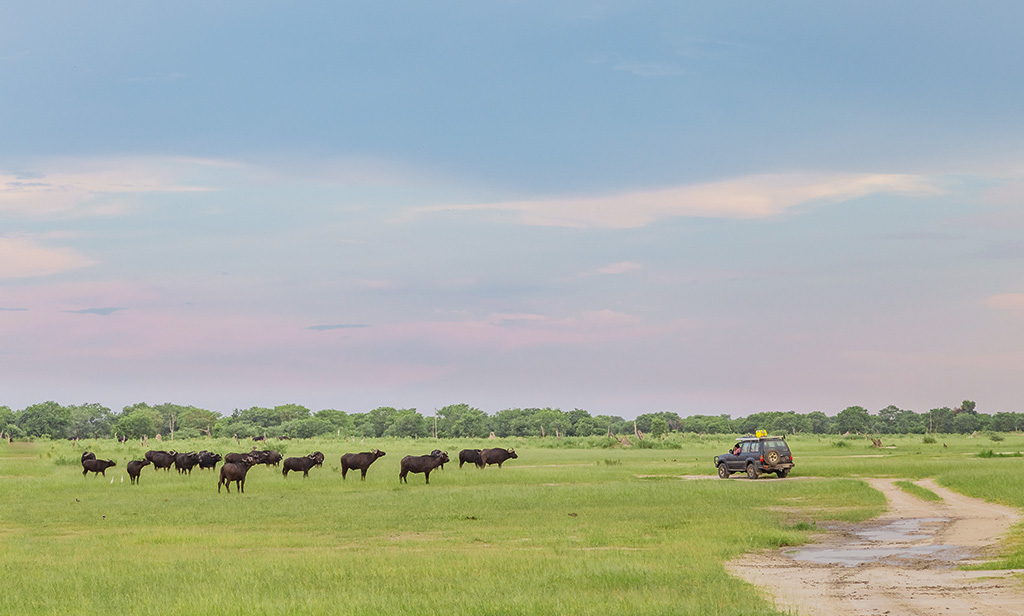
Just a tiny sample of the many hundreds of buffalo that roamed the green plains between Moremi’s Second and Third Bridge.
6 The Old Bridge Backpackers is a Maun institution and not overly busy in the green season. Camping is R107 per person. +267-686-2406. maun-backpackers.com
7. Moremi Game Reserve. The lush, open grassland around Third Bridge Camp attracts herds of zebra, wildebeest and buffalo – and cats aplenty. R435 per person (SADC rate). +267-686-22-21, xomaesites.com
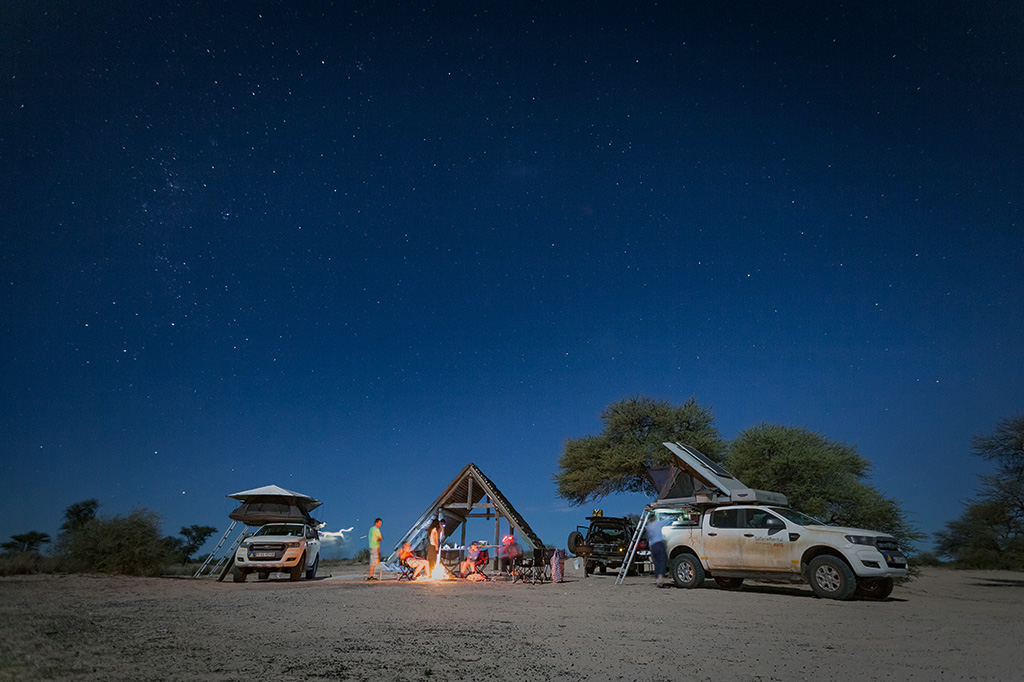
With the full moon shining down on Mabuasehube it was almost bright enough to go without a torch.
8. Nxai Pan National Park. We camped at Baines’ Baobabs 2, beneath two very leafy baobabs (move to nearby South Camp if the local Kudiakam Pan floods). R435 per person (SADC rate). +267-686-22-21, xomaesites.com
9. Limopopo River Lodge, with eight neat campsites on the Limpopo River, is a lovely stopover in the Tuli Block. R164 per person. +267-721-06098, limpoporiverlodge.co.za
Note Park entry fees are an additional R160 per person and R67 per vehicle for Khutse, Central Kalahari, Moremi and Nxai Pan, and R27 per person and R5 per vehicle for Mabuasehube. +267-318-0774, [email protected]
Cresta has a hotel in Gaborone and other main centres if you need a stopover. Cresta Marang Gardens, with chalets and camping on the Tati River, is outside Francistown. If you’re venturing up to Chobe, break from camping at Cresta Mowana Safari Lodge & Spa at Kasane. crestahotels.com









